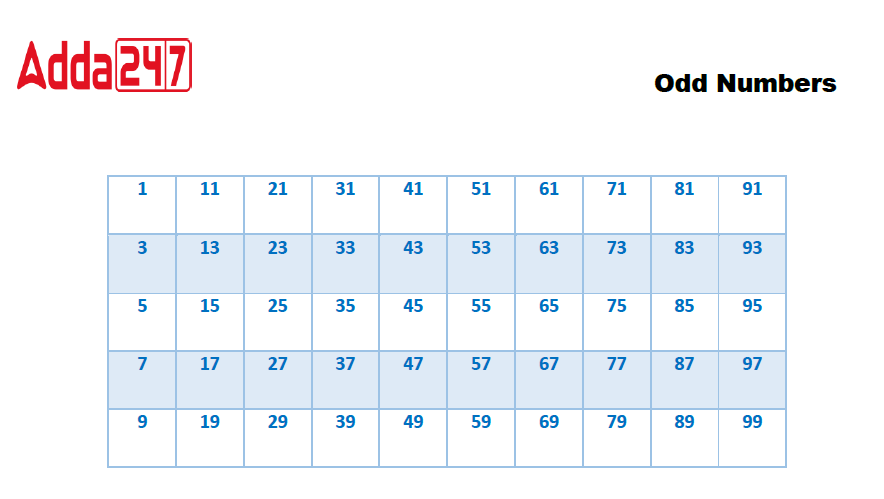Odd Numbers
Numbers that cannot be paired together are referred to be odd numbers. In other words, all numbers are odd, excluding multiples of two. In this essay, let’s study more about odd numbers.
What are odd numbers?
The definition of an odd number is a number that cannot be divided into two equal pieces. Or, to put it another way, odd numbers are positive integers that cannot be divided into sets of two. Examples include 1, 3, 5, 7, etc. Let’s use footwear and cherries as an example to help us visualise it. Assume we have shoes in the following counts: 1, 3, 5, and 7. Contrarily, we have cherries that come in pairs of 2, 4, 6, and 8. The pairing of these numbers can be understood by looking at the figure shown below.
How to check if the number is odd?
To check whether the given number is odd or even, one is required to check the number given at one’s (or unit’s) place. That particular number in one’s place will tell you whether the number is odd or even.
- Even numbers end with 0, 2, 4, 6, 8
- Odd Numbers end with 1, 3, 5, 7, 9
These are the simple tricks to identify the numbers whether they are even or not.
Think about the numbers 42, 248, and 356 which end with an even number i.e. 2, 8, and 6. Therefore, the given numbers 42, 248, and 356 are even numbers. Thus the numbers are not odd numbers. In the same way, 75, and 327 are odd numbers as they end with 5 and 7.
Odd Numbers Properties
There are three properties of even numbers which are discussed in the table given below
| PROPERTY NAME | OPERATION | EXAMPLE |
| Property of addition | odd + odd = even | 5 + 5 = 10 |
| Property of subtraction | odd – odd = even | 9 – 7 = 2 |
| Property of multiplication | odd x odd = odd | 7 x 5 = 35 |
Property of odd number addition
- Adding both even numbers will give the result of even numbers.
- Adding even and odd, the resultant will be odd.
- Adding both odd numbers will give the result of even numbers.
Property of odd number subtraction
- Subtracting even from even numbers will give the result of even numbers.
- Subtracting odd from even or even from odd, the resultant will be odd.
- Subtracting odd from odd numbers will give the result of odd numbers.
Property of odd number multiplication
- Multiplying even and even numbers will give the result of even numbers.
- Multiplying odd and even numbers, the resultant will be even.
- Multiplying odd and odd numbers will give the result of odd numbers.
Odd numbers from 1 to 100
The odd numbers from 1 to 100 are given below
1, 3, 5, 7, 9, 11, 13, 15, 17, 19, 21, 23, 25, 27, 29, 31, 33, 35, 37, 39, 41, 43, 45, 47, 49, 51, 53, 55, 57, 59, 61, 63, 65, 67, 69, 71, 73, 75, 77, 79, 81, 83, 85, 87, 89, 91, 93, 95, 97, 99.
Odd numbers from 1 to 100 Chart
A chart of odd numbers from 1 to 100 is also given that can be saved for future reference

Types of Odd Numbers
There are mainly two types of odd numbers
- Consecutive odd numbers
- Composite odd numbers
Let’s discuss the above types of odd numbers in detail
Consecutive Odd Numbers
The following are examples of consecutive odd numbers: 3, 5, 7, 9, 11, and so on. Consecutive numbers are those that consistently follow one another in order, from the smallest to the largest. For instance, the natural numbers 1, 2, 3, 4, and so forth are all sequential. Therefore, we can list all odd numbers in order from the smallest number to the largest number whenever we need to list consecutive odd numbers. For instance, the odd numbers 3, 5, 7, 9, 11 and so on are all consecutive odd numbers.
Composite Odd Numbers
A composite odd number is a positive odd integer that can be multiplied by either one or two smaller positive numbers. 9, 15, 21, 25, 27, 33, 35, 39, 45, 49, 51, 55, 57, 63, 65, 69, 75, 77, 81, 85, 87, 91, 93, 95, and 99 are the composite odd numbers up to 100.
Odd Numbers Facts
These odd number facts will spice up your math classes:
- On the number line, 1 is the first positive odd number.
- Any integer that cannot be divided by two is considered odd.
- The outcome of dividing an odd integer by two is always one.
- Even numbers have the numbers 0, 2, 4, 6, or 8, while odd numbers have the digits 1, 3, 5, 7, or 9.
List of Odd Numbers
Between 1 and 50, there are 25 odd numbers, while between 1 and 100, there are 50. There are 500 odd numbers and 500 even numbers in the range of 1 to 1000.
| Number Range | No. of Odd Numbers |
| 1 to 50 | 25 |
| 1 to 100 | 50 |
| 1 to 200 | 100 |
| 1 to 300 | 150 |
| 1 to 500 | 250 |
| 1 to 1000 | 500 |
| 1 to 10000 | 5000 |
Related articles:
Odd Numbers Examples
Que: Find the sum of the smallest and the largest 3 digits odd numbers and also prove that it is divisible by 2.
Solution: Smallest 3 digit odd number = 101
Largest 3 digit odd number = 999
Sum of both the numbers = 101 + 999 = 1100
The number 1100 is divisible by 2 (as per the divisibility rule of 2).
This proves that the number is even.
Que: Are the following numbers odd or even?
- 23
- 13 + 17
- 39 – 37
Solution:
- 23 is not divisible by 2, so odd number.
- 13 + 17 = 30, divisible by 2, not an odd number
- 39 – 37 = 2, is an even number









 Bihar Board Sent Up Answer Key 2025-26, ...
Bihar Board Sent Up Answer Key 2025-26, ...
 Best CUET Offline Coaching in Preet Viha...
Best CUET Offline Coaching in Preet Viha...
 EMS Results 2025 OUT, Download RGUHS Mar...
EMS Results 2025 OUT, Download RGUHS Mar...


















